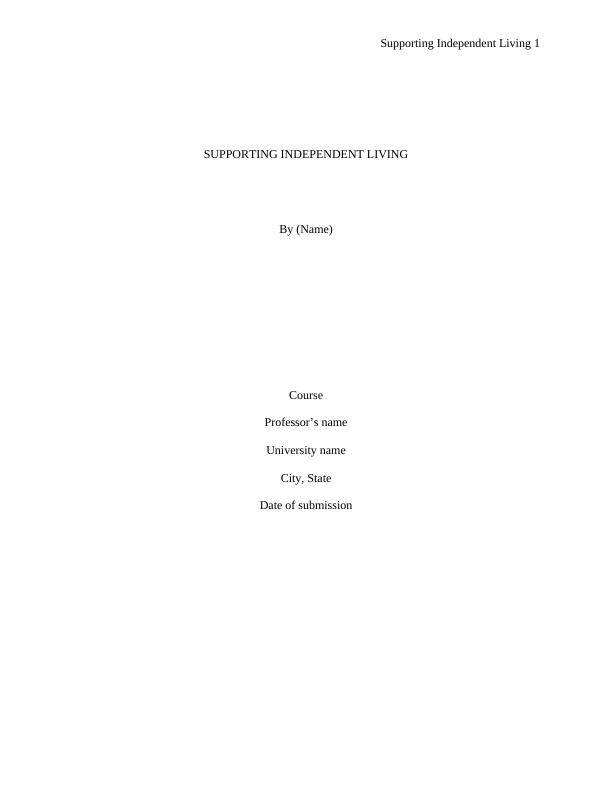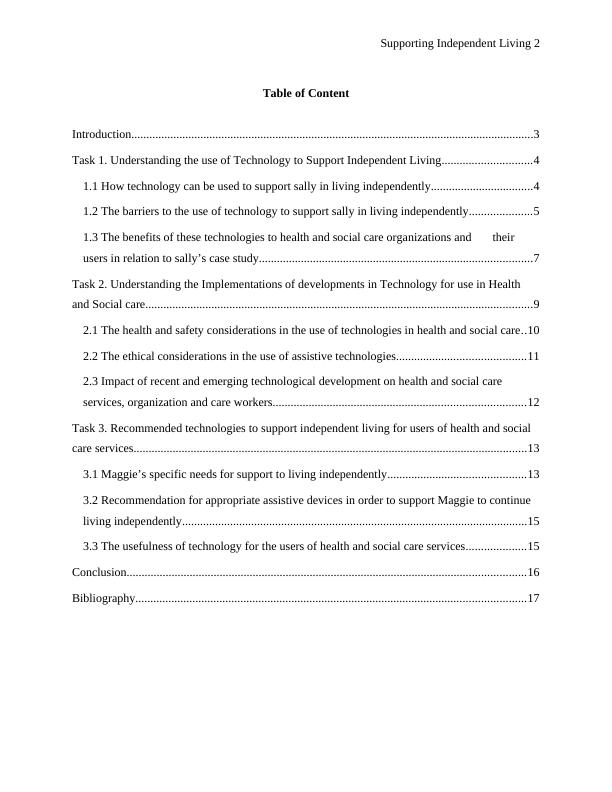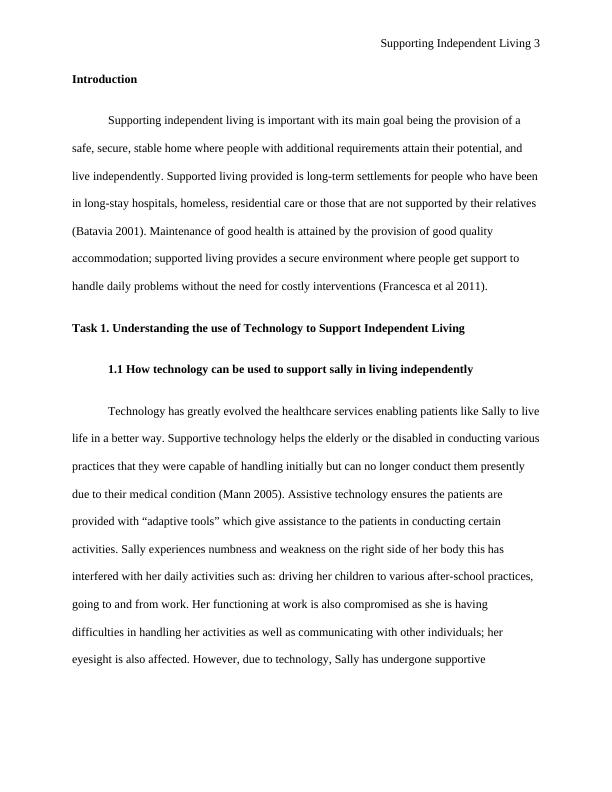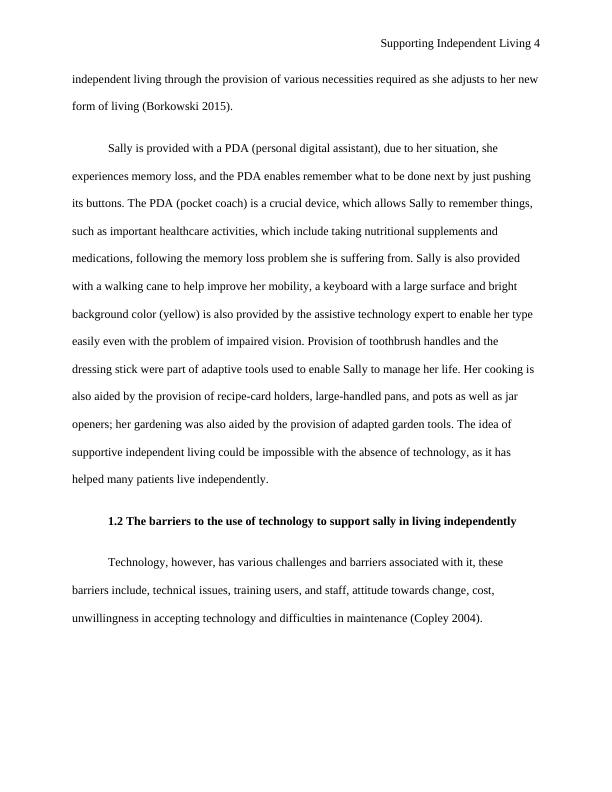Supporting Independent Living: Understanding the Use of Technology and Implementations of Developments in Health and Social Care
Added on 2023-06-14
19 Pages4813 Words59 Views
Supporting Independent Living 1
SUPPORTING INDEPENDENT LIVING
By (Name)
Course
Professor’s name
University name
City, State
Date of submission
SUPPORTING INDEPENDENT LIVING
By (Name)
Course
Professor’s name
University name
City, State
Date of submission

Supporting Independent Living 2
Table of Content
Introduction......................................................................................................................................3
Task 1. Understanding the use of Technology to Support Independent Living..............................4
1.1 How technology can be used to support sally in living independently..................................4
1.2 The barriers to the use of technology to support sally in living independently.....................5
1.3 The benefits of these technologies to health and social care organizations and their
users in relation to sally’s case study...........................................................................................7
Task 2. Understanding the Implementations of developments in Technology for use in Health
and Social care.................................................................................................................................9
2.1 The health and safety considerations in the use of technologies in health and social care..10
2.2 The ethical considerations in the use of assistive technologies...........................................11
2.3 Impact of recent and emerging technological development on health and social care
services, organization and care workers....................................................................................12
Task 3. Recommended technologies to support independent living for users of health and social
care services...................................................................................................................................13
3.1 Maggie’s specific needs for support to living independently..............................................13
3.2 Recommendation for appropriate assistive devices in order to support Maggie to continue
living independently...................................................................................................................15
3.3 The usefulness of technology for the users of health and social care services....................15
Conclusion.....................................................................................................................................16
Bibliography..................................................................................................................................17
Table of Content
Introduction......................................................................................................................................3
Task 1. Understanding the use of Technology to Support Independent Living..............................4
1.1 How technology can be used to support sally in living independently..................................4
1.2 The barriers to the use of technology to support sally in living independently.....................5
1.3 The benefits of these technologies to health and social care organizations and their
users in relation to sally’s case study...........................................................................................7
Task 2. Understanding the Implementations of developments in Technology for use in Health
and Social care.................................................................................................................................9
2.1 The health and safety considerations in the use of technologies in health and social care..10
2.2 The ethical considerations in the use of assistive technologies...........................................11
2.3 Impact of recent and emerging technological development on health and social care
services, organization and care workers....................................................................................12
Task 3. Recommended technologies to support independent living for users of health and social
care services...................................................................................................................................13
3.1 Maggie’s specific needs for support to living independently..............................................13
3.2 Recommendation for appropriate assistive devices in order to support Maggie to continue
living independently...................................................................................................................15
3.3 The usefulness of technology for the users of health and social care services....................15
Conclusion.....................................................................................................................................16
Bibliography..................................................................................................................................17

Supporting Independent Living 3
Introduction
Supporting independent living is important with its main goal being the provision of a
safe, secure, stable home where people with additional requirements attain their potential, and
live independently. Supported living provided is long-term settlements for people who have been
in long-stay hospitals, homeless, residential care or those that are not supported by their relatives
(Batavia 2001). Maintenance of good health is attained by the provision of good quality
accommodation; supported living provides a secure environment where people get support to
handle daily problems without the need for costly interventions (Francesca et al 2011).
Task 1. Understanding the use of Technology to Support Independent Living
1.1 How technology can be used to support sally in living independently
Technology has greatly evolved the healthcare services enabling patients like Sally to live
life in a better way. Supportive technology helps the elderly or the disabled in conducting various
practices that they were capable of handling initially but can no longer conduct them presently
due to their medical condition (Mann 2005). Assistive technology ensures the patients are
provided with “adaptive tools” which give assistance to the patients in conducting certain
activities. Sally experiences numbness and weakness on the right side of her body this has
interfered with her daily activities such as: driving her children to various after-school practices,
going to and from work. Her functioning at work is also compromised as she is having
difficulties in handling her activities as well as communicating with other individuals; her
eyesight is also affected. However, due to technology, Sally has undergone supportive
Introduction
Supporting independent living is important with its main goal being the provision of a
safe, secure, stable home where people with additional requirements attain their potential, and
live independently. Supported living provided is long-term settlements for people who have been
in long-stay hospitals, homeless, residential care or those that are not supported by their relatives
(Batavia 2001). Maintenance of good health is attained by the provision of good quality
accommodation; supported living provides a secure environment where people get support to
handle daily problems without the need for costly interventions (Francesca et al 2011).
Task 1. Understanding the use of Technology to Support Independent Living
1.1 How technology can be used to support sally in living independently
Technology has greatly evolved the healthcare services enabling patients like Sally to live
life in a better way. Supportive technology helps the elderly or the disabled in conducting various
practices that they were capable of handling initially but can no longer conduct them presently
due to their medical condition (Mann 2005). Assistive technology ensures the patients are
provided with “adaptive tools” which give assistance to the patients in conducting certain
activities. Sally experiences numbness and weakness on the right side of her body this has
interfered with her daily activities such as: driving her children to various after-school practices,
going to and from work. Her functioning at work is also compromised as she is having
difficulties in handling her activities as well as communicating with other individuals; her
eyesight is also affected. However, due to technology, Sally has undergone supportive

Supporting Independent Living 4
independent living through the provision of various necessities required as she adjusts to her new
form of living (Borkowski 2015).
Sally is provided with a PDA (personal digital assistant), due to her situation, she
experiences memory loss, and the PDA enables remember what to be done next by just pushing
its buttons. The PDA (pocket coach) is a crucial device, which allows Sally to remember things,
such as important healthcare activities, which include taking nutritional supplements and
medications, following the memory loss problem she is suffering from. Sally is also provided
with a walking cane to help improve her mobility, a keyboard with a large surface and bright
background color (yellow) is also provided by the assistive technology expert to enable her type
easily even with the problem of impaired vision. Provision of toothbrush handles and the
dressing stick were part of adaptive tools used to enable Sally to manage her life. Her cooking is
also aided by the provision of recipe-card holders, large-handled pans, and pots as well as jar
openers; her gardening was also aided by the provision of adapted garden tools. The idea of
supportive independent living could be impossible with the absence of technology, as it has
helped many patients live independently.
1.2 The barriers to the use of technology to support sally in living independently
Technology, however, has various challenges and barriers associated with it, these
barriers include, technical issues, training users, and staff, attitude towards change, cost,
unwillingness in accepting technology and difficulties in maintenance (Copley 2004).
independent living through the provision of various necessities required as she adjusts to her new
form of living (Borkowski 2015).
Sally is provided with a PDA (personal digital assistant), due to her situation, she
experiences memory loss, and the PDA enables remember what to be done next by just pushing
its buttons. The PDA (pocket coach) is a crucial device, which allows Sally to remember things,
such as important healthcare activities, which include taking nutritional supplements and
medications, following the memory loss problem she is suffering from. Sally is also provided
with a walking cane to help improve her mobility, a keyboard with a large surface and bright
background color (yellow) is also provided by the assistive technology expert to enable her type
easily even with the problem of impaired vision. Provision of toothbrush handles and the
dressing stick were part of adaptive tools used to enable Sally to manage her life. Her cooking is
also aided by the provision of recipe-card holders, large-handled pans, and pots as well as jar
openers; her gardening was also aided by the provision of adapted garden tools. The idea of
supportive independent living could be impossible with the absence of technology, as it has
helped many patients live independently.
1.2 The barriers to the use of technology to support sally in living independently
Technology, however, has various challenges and barriers associated with it, these
barriers include, technical issues, training users, and staff, attitude towards change, cost,
unwillingness in accepting technology and difficulties in maintenance (Copley 2004).

End of preview
Want to access all the pages? Upload your documents or become a member.
Related Documents
Technological Support for Independent Livinglg...
|12
|3960
|408
HNC/HND Supporting Independent Livinglg...
|16
|4050
|28
Supporting Independent Living: Assignmentlg...
|12
|3758
|142
Supporting Independent Living | Assignmentlg...
|12
|4252
|37
Supporting Independent Living: Assignment Samplelg...
|12
|4288
|29
Supporting Independent Living - Doclg...
|13
|3989
|31